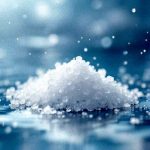Takeaways
- Excess sodium intake can lead to serious health issues
- Symptoms of sodium toxicity include swelling and high blood pressure
- Reducing processed foods helps lower sodium consumption
- Reading nutrition labels is essential for monitoring sodium intake
- Herbs and spices offer flavorful alternatives to salt
- Gradual reduction helps adjust taste preferences over time
Understanding Sodium and Its Role in the Body
Sodium is a vital mineral that helps the body function correctly. It plays a role in maintaining fluid balance and nerve function.[1] People primarily get sodium from the salt they consume in their daily diet.
The body carefully controls the amount of sodium it contains. While some sodium is needed, too much can be harmful. Most adults should aim to consume less than 2,300 mg of sodium per day.[2]
Sodium occurs naturally in foods such as vegetables, dairy products, and meats. However, the majority of dietary sodium comes from processed and restaurant foods.[3] Being mindful of where sodium comes from can help in keeping a healthy intake level.
What is Sodium Toxicity?
Sodium toxicity develops when there is too much sodium in the body.[4] This can result from eating excessive amounts of sodium over extended periods. Certain medical conditions can also lead to this imbalance.
Excessive sodium intake leads to toxicity because it disrupts the body’s fluid balance. As sodium levels increase, it draws more water into the bloodstream.[5] This causes an increase in blood volume, which puts additional stress on the heart and blood vessels.
There are two primary types of sodium toxicity: acute and chronic. Acute toxicity occurs suddenly after consuming a very large amount of sodium.[6] Chronic toxicity develops over time due to a long-term diet high in sodium.
Signs and Symptoms of Sodium Toxicity
Physical Symptoms
Sodium toxicity can cause noticeable physical symptoms. These symptoms often arise from fluid retention and imbalances in the body’s electrolytes.[7]
Common physical symptoms include:
- Swelling in hands, feet, and face
- Increased thirst
- Headache
- Nausea and vomiting
- Abdominal cramps
These symptoms occur because too much sodium causes the body to retain more water than normal. This leads to swelling and other related issues.[8]
Cognitive and Neurological Effects
Sodium toxicity can also affect brain function. An excessive amount of sodium can interfere with normal nerve signaling and brain activity.[9]
Some cognitive effects of sodium toxicity include confusion, irritability, and changes in mood. In severe situations, it could lead to seizures or loss of consciousness.[10]
Excess sodium impacts the brain by altering fluid balance. This can result in brain swelling and changes in mental function.[11] Recognizing these effects quickly is key to avoiding serious issues.
Risk Factors for Sodium Toxicity
Various factors can increase a person’s risk of developing sodium toxicity. Understanding these risks can help people who need to be extra cautious about their sodium intake.[12]
| Risk Factor | Impact on Sodium Toxicity |
|---|---|
| Age | Older adults are more sensitive to sodium |
| Kidney disease | Reduced ability to remove excess sodium |
| Heart failure | Fluid retention increases sodium sensitivity |
| High blood pressure | More susceptible to sodium’s effects |
| Certain medications | May alter sodium balance in the body |
These risk factors can contribute to sodium toxicity in different ways. For example, kidneys may not filter sodium as effectively as people get older.[13] Some heart conditions can make a person more sensitive to the effects of sodium on blood pressure.
Diagnosing Sodium Toxicity
Diagnosing sodium toxicity involves looking at the symptoms and measuring sodium levels in the body.[14] Doctors will use different tests to confirm their diagnosis.
The diagnostic process usually begins with a physical exam and a review of the person’s symptoms. Doctors may ask about diet, medications, and medical history to find possible reasons for the high sodium.
Typical diagnostic methods for sodium toxicity include:
- Blood tests to measure serum sodium levels
- Urine tests to assess sodium excretion
- Imaging studies to check for fluid retention
These tests help determine the seriousness of the sodium toxicity and assist in making treatment decisions. Diagnosing it early is important for preventing complications.[15]
Health Consequences of Chronic High Sodium Intake
Cardiovascular Issues
Excess sodium intake has a significant effect on the cardiovascular system. It can cause high blood pressure, which is a major risk factor for heart disease and stroke.[16]
High sodium levels cause the body to hold onto more water. This increases the volume of blood and puts extra pressure on the walls of the blood vessels.[17] Over time, this can damage the blood vessels and strain the heart.
Studies show a clear link between high sodium intake and high blood pressure. Reducing sodium intake often leads to a decrease in blood pressure, especially in individuals who are sensitive to salt.[18]
Kidney Problems
The kidneys are essential for regulating sodium levels. Consistently high sodium intake can overwork and damage these important organs.[19]
Excess sodium makes the kidneys work harder to filter blood. This extra work can reduce kidney function over time.[20] People with existing kidney problems are at a greater risk.
Long-term high sodium intake can contribute to the development of kidney disease. It can also worsen existing kidney problems, making it more difficult for the body to maintain proper fluid balance.[21]
Bone Health
Sodium intake affects not just the heart and kidneys but also bone health, through its impact on calcium balance.[22]
High sodium consumption increases how much calcium is excreted through urine. This means the body loses more calcium, which is needed for maintaining strong bones.[23]
Over time, consuming too much sodium may lead to reduced bone density. This could potentially increase the risk of developing osteoporosis, especially in older adults.[24]
Treating Sodium Toxicity
Treatment for sodium toxicity focuses on bringing sodium levels in the body back to normal.[25] The specific approach will depend on how severe the condition is and what is causing it.
Steps in treating acute sodium toxicity:
- Stop sodium intake
- Provide intravenous fluids
- Monitor electrolyte levels
- Treat symptoms as needed
- Address underlying causes
For milder cases, reducing sodium intake and drinking more water may be sufficient. However, severe cases often require medical intervention to lower sodium levels safely.[26]
Long-term management of chronic high sodium intake involves lifestyle changes. This includes adopting a low-sodium diet and treating any related health issues.
Preventing Sodium Toxicity
Dietary Strategies
Preventing sodium toxicity starts by managing the amount of sodium consumed in your diet. Making simple changes can significantly reduce daily sodium intake.[27]
Foods high in sodium to limit or avoid:
- Processed meats (bacon, ham, sausage)
- Canned soups and vegetables
- Fast food and restaurant meals
- Salty snacks (chips, pretzels)
- Condiments (ketchup, soy sauce)
Reading food labels is important for tracking your sodium intake. Look for terms like “low sodium” or “no salt added.” Compare sodium content between similar products to make healthier choices.[28]
When cooking at home, use fresh ingredients and limit added salt. Slowly reducing salt in recipes will help your taste adjust over time.[29]
Lifestyle Changes
Beyond diet, other lifestyle changes can help prevent sodium toxicity. These changes support overall health and make it easier to maintain a low-sodium lifestyle.
Staying properly hydrated is important for balancing electrolytes, including sodium. Drink water throughout the day, particularly when consuming foods higher in sodium.[30]
Regular exercise helps to regulate blood pressure and supports kidney function. It also promotes sweating, which can help remove excess sodium from the body.[31]
Stress management techniques, such as meditation or yoga, may indirectly help. Stress can increase cravings for salty foods and cause blood pressure to rise.[32]
Sodium Alternatives and Substitutes
Finding tasty alternatives to salt helps to reduce sodium intake without sacrificing flavor. Many options can improve the taste of food without adding sodium.
| Salt Substitute | Sodium Content (per tsp) |
|---|---|
| Table salt | 2,325 mg |
| Potassium chloride | 0 mg |
| Herb blends | 0-5 mg |
| Lemon juice | 1 mg |
| Vinegar | 0 mg |
Using herbs and spices adds flavor without adding sodium. Try fresh or dried options like basil, oregano, or cumin. Experiment to find combinations you enjoy.[33]
Acidic ingredients such as lemon juice or vinegar can brighten flavors. They work well in marinades or as a finishing touch on dishes.[34]
Gradually reducing the amount of salt used while cooking allows your taste buds to adjust. Over time, you may find you need less salt to enjoy foods.[35]
Myths and Misconceptions About Sodium
Many myths surround sodium intake and its effects on health. Understanding the facts can help you make informed decisions about sodium consumption.
Common misconceptions about sodium:
- All salt is bad for health
- Sea salt is healthier than table salt
- You should eliminate all sodium from your diet
- Only older people need to worry about sodium intake
- If you don’t add salt to food, you’re safe from excess sodium
In reality, sodium is necessary for health in the correct amounts. Different kinds of salt contain similar amounts of sodium.[36] Completely eliminating sodium is not recommended.
Everyone, regardless of age, should be aware of their sodium intake. Most dietary sodium comes from processed foods, rather than added table salt.[37]
Evidence-based information is very important for understanding the role sodium plays in health. Consult trusted sources or healthcare providers for correct guidance on sodium intake.
Special Considerations for Specific Populations
Athletes and Active Individuals
Athletes and very active people have unique sodium needs. Intense exercise causes sodium loss through sweat, which needs to be replaced.[38]
These individuals may require more sodium than the general population. The exact amount needed depends on factors such as how intense and long their exercise sessions are.[39]
Balancing sodium intake with increased fluid loss is important. Sports drinks can help to replenish electrolytes during long or intense workouts.[40]
However, most people do not need extra sodium for moderate exercise. Regular water intake is usually enough for shorter, less intense activities.[41]
Older Adults
Aging can affect how the body processes sodium. Older adults often become more sensitive to sodium’s impact on blood pressure.[42]
As people get older, their kidneys may become less efficient at filtering sodium. This can increase the risk of retaining fluid and developing high blood pressure.[43]
Tips for managing sodium intake in older populations:
- Choose fresh, whole foods over processed options
- Use herbs and spices for flavor instead of salt
- Be cautious with salt substitutes containing potassium
- Stay hydrated with water or low-sodium beverages
Older adults should work closely with healthcare providers to monitor their sodium intake. This is especially important for those who already have existing health conditions.[44]
People with Chronic Health Conditions
Certain health conditions require specific attention to sodium intake. Conditions such as heart failure, kidney disease, and liver problems often require careful sodium control.[45]
For these individuals, recommended sodium levels may be lower than for the general population. A healthcare provider can offer specific advice based on individual health needs.[46]
It’s important to balance restricting sodium with overall nutrition. Working with a dietitian can help you create a healthy, low-sodium meal plan that meets all your nutritional needs.
Monitoring Sodium Intake
Keeping track of your daily sodium consumption helps you maintain a healthy intake. Various tools and techniques can make this process easier.[47]
Tools and techniques for monitoring sodium intake:
- Food diary apps
- Nutrition label reading
- Home-cooked meals
- Measuring salt used in cooking
- Restaurant menu nutrition information
These methods help to identify hidden sources of sodium in your diet. They also raise awareness of overall sodium consumption patterns.[48]
Reducing sodium gradually is often the most effective approach for lowering sodium intake. Start by targeting foods that are high in sodium and finding lower-sodium alternatives.[49]
Set realistic goals for sodium reduction. Try to decrease your intake by small amounts each week. This allows your taste preferences to adjust over time.
The Future of Sodium Research
Ongoing research continues to explore sodium’s role in health. Scientists are investigating how sodium affects different systems and populations within the body.[50]
Current areas of study include:
- Genetic factors influencing salt sensitivity
- Impact of sodium on gut microbiome
- Potential links between sodium and autoimmune diseases
- Development of more accurate methods for measuring sodium intake
These studies may lead to more personalized recommendations for sodium intake. They could also lead to new ways to prevent or treat health issues that are related to sodium.
As research continues, our understanding of sodium’s effect on the body will likely change. Stay informed about new findings in order to make the best choices for your health.[51]
FAQ: People Also Ask
What are the symptoms of too much sodium in your body?
How much sodium per day is too much?
Can you flush sodium out of your body?
How long does it take to lower sodium levels in the body?
Is sea salt healthier than table salt?
Can low sodium levels be dangerous?
What foods are surprisingly high in sodium?
How does sodium affect blood pressure?
Sodium is a key electrolyte that helps regulate fluid volume, nerve impulses, and muscle contractions.
Source: “Dietary Guidelines for Americans, 2020–2025: Understanding the Scientific Process, Guidelines, and Key Recommendations” https://www.ncbi.nlm.nih.gov/pmc/articles/PMC8713704/
This recommendation is based on the association between high sodium intake and increased risk of hypertension and cardiovascular disease.
Source: “Dietary Guidelines for Americans, 2020–2025: Understanding the Scientific Process, Guidelines, and Key Recommendations” https://www.ncbi.nlm.nih.gov/pmc/articles/PMC8713704/
Processed and restaurant foods often have added sodium for preservation and flavor enhancement, leading to excessive intake.
Source: “Mechanism-based strategies to prevent salt sensitivity and salt-induced hypertension” https://www.ncbi.nlm.nih.gov/pmc/articles/PMC9069470/
This condition can arise from excessive sodium intake, impaired sodium excretion, or fluid loss.
The increased water retention increases blood volume, which can put additional stress on the heart and blood vessels.
Acute toxicity happens rapidly after high sodium intake, while chronic toxicity results from prolonged high intake.
Symptoms can include swelling, increased thirst, headache, and in severe cases, confusion or seizures.
This fluid retention occurs because the body tries to dilute the increased sodium concentration in the blood.
This disruption in nerve function can lead to various cognitive and neurological symptoms.
These symptoms arise from disruptions in the brain’s electrolyte balance and fluid shifts.
The osmotic changes caused by high sodium levels can lead to fluid shifts within the brain.
These factors can affect how well the body regulates sodium levels.
Reduced kidney function in older adults can make them more susceptible to sodium imbalances.
Blood tests are used to determine sodium levels. Symptoms can help identify causes.
Early diagnosis is important for initiating appropriate treatment and preventing complications related to sodium imbalances.
Excessive sodium intake leads to fluid retention and an increased blood volume which puts added pressure on blood vessels and the heart.
Source: “Dietary Guidelines for Americans, 2020–2025: Understanding the Scientific Process, Guidelines, and Key Recommendations” https://www.ncbi.nlm.nih.gov/pmc/articles/PMC8713704/
This pressure increase contributes to the development of hypertension.
Individuals with salt sensitivity may experience a greater reduction in blood pressure with reduced sodium intake.
Source: “Mechanism-based strategies to prevent salt sensitivity and salt-induced hypertension” https://www.ncbi.nlm.nih.gov/pmc/articles/PMC9069470/
The kidneys filter excess sodium from the blood, and prolonged high sodium intake can overwork and potentially harm the kidneys.
This extra work can lead to a decline in kidney function and increase risk of kidney disease.
The extra work required by kidneys to filter excess sodium can cause damage and impair the kidneys’ ability to regulate fluid balance.
High sodium intake can increase calcium excretion, which may have negative impacts on bone health.
Increased sodium intake can cause the kidneys to excrete more calcium, which reduces the body’s supply of this mineral.
Source: “Sodium and bone health: impact of moderately high and low salt intakes on calcium metabolism in postmenopausal women” https://pubmed.ncbi.nlm.nih.gov/18410231/
The increased calcium excretion due to high sodium intake can impact bone density and increase the risk of osteoporosis.
Source: “Sodium and bone health: impact of moderately high and low salt intakes on calcium metabolism in postmenopausal women” https://pubmed.ncbi.nlm.nih.gov/18410231/
The treatment strategies vary based on the severity of the condition and can include IV fluids and medications.
This could involve the use of intravenous fluids with a specific sodium concentration, and possibly medications.
Limiting processed foods, reading food labels, and avoiding the use of table salt are effective strategies.
This practice can help consumers identify hidden sources of sodium in their diet.
This can help improve food flavors without relying on excessive salt.
Drinking water helps the kidneys process sodium and remove excess amounts.
Consistent physical activity is a key aspect of overall health and can help manage sodium levels in the body.
Managing stress can be beneficial to overall health, reducing cravings for salty foods, and indirectly reducing sodium intake.
Using herbs and spices is a healthy alternative to adding sodium.
These ingredients provide a different flavor profile that does not rely on salt.
By slowly decreasing the amount of salt used, people can retrain their taste preferences to be less reliant on salt.
The body needs sodium to function properly but too much can cause harm. While salt varieties may have trace differences in other minerals, the sodium content is generally similar.
Because of high levels in processed foods it is more important to be mindful of processed food intake than salt used in cooking.
This loss needs to be considered when planning dietary intake.
The amount of sodium that needs to be replaced varies.
Sports drinks can aid in replacing both electrolytes and fluids.
Regular water intake is usually sufficient for hydration in shorter, less intense activities.
The body’s ability to process sodium can change with age.
Older adults need to be especially careful of sodium intake.
Regular monitoring is particularly important for those with existing health conditions.
Careful sodium management is necessary for these individuals to help manage their conditions.
Healthcare providers should be consulted to make specific individual recommendations.
Tools and methods can help individuals track their intake.
Tracking can help individuals identify hidden sodium sources and make informed decisions.
Gradual changes are easier to maintain than drastic changes and can help individuals adjust their taste preferences.
Scientists are working to better understand sodium and its impact on the body.
Staying informed on new findings is important to ensure a healthy lifestyle.



